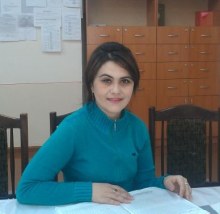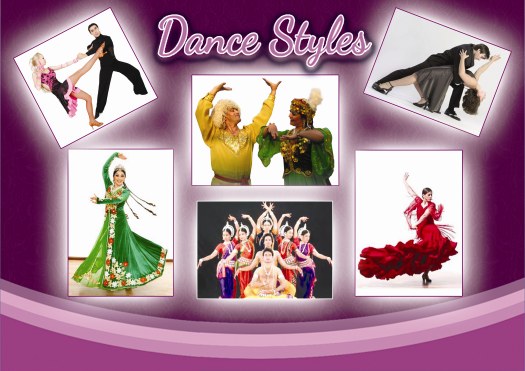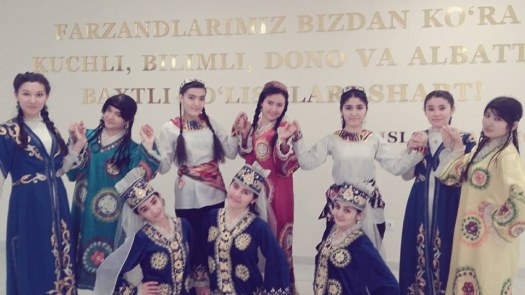Using the Context of Dance in Language Classes
Rokhatoy Boltaeva, Uzbekistan

Rokhatoy Boltaeva has been working as a teacher of English at the Uzbekistan State University of world languages since 2004. She is responsible for teaching graduate students on: integrated skills, writing and DUET (Developing Uzbekistan English Language Teachers), which is considered to be a methodology course for graduate students. She also works as a teacher-trainer at the Republican pedagogical innovation centre under World Languages University. Her current teaching duties and responsibilities are: teaching English, training EL teachers, creating and designing materials for the students' studies, supervising researchers and being active in the work of several projects like PRESETT, DUET and ENSPIRE-U projects of British Council in Uzbekistan. As a member of UzTEA (Uzbekistan Teachers of English Association) she is a regular conference-goer and presenter at UzTEA conferences held annually in Uzbekistan. Being a member of IATEFL and TESOL-Arabia gives her a great opportunity to be in a current flow of Teaching English around the world. E-mail: rohatoy81@mail.ru
Menu
Background
Vocabulary activity (miming)
Reading and performing
Group work activity (creating a poster)
Reflective writing
Conclusion
References
I had an incredibly amazing week in Birmingham attending and presenting at the IATEFL’s 50th anniversary from 12th to 16th of April. This conference has been a fantastic one and I have loads of positive impression about IATEFL Conference, made lots of friends and useful contacts, met real authors of the books and I’m extremely delighted to be a part of it owing to the Creativity Group scholarship.
My presentation at IATEFL in Birmingham was devoted to “Implementation of Dance into English language classroom”. Educators are encouraged to create authentic learning activities. (Bonnema 2009, 21). Dancing to learn the rhythm of a language, retain vocabulary or to connect more genuinely with a culture all create an opportunity for students to activate physical and emotional pathways that enhance memory input. Besides involving movement, dance is an expression of a culture; it is a great vehicle for not only meeting different learning styles, but arguably and most importantly, it allows students to better understand the complexities of a culture. As Patrick Moran states throughout his book, Teaching Culture: Perspectives in Practice (2001), there are many entry points into a culture, and dance is one that I have found to generate a lot of substantial interest from students and allows me to connect more deeply with them. EFL teachers can use dance as the content of a lesson for the purpose of developing students’ language skills, creativity and imagination. Teaching English through dance is both effective and rewarding. There exist different motivational activities connected with dance in order to use with different levels of students adapting the activities from elementary to advanced. Although Uzbekistan has a beautiful history of dancing, representative of its historical era, struggles, technology, and sense of growth, dancing is still widely perceived as having mostly entertainment value and not as much pedagogical value, especially in language teaching.
My teaching background is mostly with university students, but the ideas in this article can be used with all age groups. In my teaching practice, we have the subject Integrated Skills in the Year 1 and 2 in the PRESETT curriculum. This lesson is once a week and each month the students are required to do final project work. I decided to implement Dance into my lesson finding the closest topic in the curriculum. In year 2 we have the topic Cross-cultural communication which is very close to Dance topic. We started the lesson discussing about Uzbek national dance. Like in many other nations, dancing in Uzbekistan has evolved regionally and some of its varieties became popular on a national level like tanovar, lazgi, polka, for instance. Uzbek dance is characterized by elegant movements of the upper body. The arm movements range from beautiful arcs above the head to fluid sweeps across the body and are complemented by hand gestures and wrist circles. The chin and shoulders serve to accentuate particular beats in the music. The dance is fluid and travels across the stage, incorporating twirls and spins but it does not resemble ballet or lyrical dance due to the absence of leaps, jumps, or pirouettes. While the dance can be performed solo, the group repertoires are fascinating as the compositions work like a mosaic of geometrically‐staged movement and color.
Below I’d like to enumerate several activities to use in using Dance in foreign language classroom:
This activity for the students can be about different styles of dancing throughout the world. Each and every student is more or less aware of dance styles throughout the world. And there is no person in the world that cannot perform their own culture's dance movements. Even though s/he can't actually dance in a brilliant way, s/he can somehow perform it in a way that any person could recognize the hidden meaning from particular actions. As Dancing is considered to be a living language, it carries some meanings of particular feelings.
Image 1. Dance styles

In order to perform this activity the students are given the separate cards with the pictures where various dance styles are described. The task for the students will be to find out the name of the particular dance. Another task for this activity can be to tell the steps, i.e. how to perform the dance on their cards. Variation for this activity can be the cards with the name of the dance will be given to the students, and their task will be to show (mime) the movements of the dance without telling it orally. The other students must guess which type of dance has been performed. Then a student can tell how it can be performed.(Using verbs describing actions, adverbs-how it’s done and adjectives-movement styles)
Read the instructions of traditional Khorezm dance “lazgi” and perform the activity:
Formation: Make a semi-circle or line
Starting position 1: raise your right hand above your head shaking it slightly.
Step 2: do the same step with your left hand
Step 3: start trembling your fingers slowly joining your arms, and then moving shoulders up and down.
Step 4: hands are slowly twisted adjusting them to the tune.
Step 5: (twisting the hands they spin around, snapping the fingers, shoulder shaking, etc)
Step 6: Then the whole body starts dancing from slow movements turning into more quickly living actions.
Having done all the steps, it’s better to perform all the steps once again with the music forming a circle.
Variation of this activity can be listening and performing
Students do a pair work activity, where they age given 2 different cards with the instruction of two different types of dances. Student A reads his card to Student B, whereas Student B follows his instructions and dances accordingly. The task is done in the same way with the second card.
This activity is about creating a poster where the students write the instructions of one type of dance, which is related to their culture, illustrating it with lively dance movements. In order to perform the activity the students are grouped into smaller groups and choose which dance style to illustrate for (It would be better if students are grouped according to the regions, so that to describe one particular region’s dance style). Afterwards, the students are asked to present their product in their posters to others groups and actually dance with a related live music. They can also make a project work in the form of video presentation or produce a dance book split into four chapters, where they include history of the dance, clothes and accessories related to the dance, steps of dance, the list of the songs and links to this particular style of dance and group photos taken while performing the dance. In my case students performed dances from 5 different regions (Surkhandarya, Bukhara, Kharezm, Andijan and Karakalpak)
Image 2. Students of Uzbekistan State University of World Languages

Another activity for students can be to reflect on their dancing after they have done their project works. Thus, the task for students can be given either in the narrative written form or in oral one, where they express their feelings while they dance to each particular style of dancing. This activity is especially useful to overcome shyness in the students.
Structure of reflective writing
- Description of dance
- Reaction and feelings
- What was performed well and which steps caused you to fail performance
- Analysis
- Conclusion
- Action plan: what are you going to do differently in this type of dance project?
Dance review is also a good task, where students watch one particular dance performance and write a review of it.
DANCE REVIEW
INTRODUCTION:
TYPE OF THE DANCE OR NAME, PERFORMERS AND ORIGIN
BODY:
PLOT OF THE DANCE, HOW IT’S PERFORMED, POSITIVE AND NEGATIVE FEELINGS ABOUT THE PERFORMED DANCE
CONCLUSION:
SPECIFIC CONCLUSION AND SUGGESSTED RECOMMENDATIONS
The last activity is connected with creating a new type of dance. A teacher gives students cards where students are asked to sit in a circle so that each of them has to pass the card to the person next to him after writing each step. Swiping continues until the last step is written. Afterwards the students are asked to name it and dance accordingly.
Invent a new type of dance
STEP 1:__________________________________________________________________
STEP 2:__________________________________________________________________
STEP 3:__________________________________________________________________
STEP 4:__________________________________________________________________
STEP 5:__________________________________________________________________
IT IS A(N)________________________DANCE
Thus, above mentioned activities can open doors to discovery of unrealized talents and interests, supporting problem-solving, collaboration, and other communication skills in a fresh and provocative way. Being an insider to Uzbek culture, I have grown up with lazgi as part of my life, just as watching television or doing my homework. The steps leading up to dancing helps the students become more aware of themselves and they become unconsciously creative. Through the process of learning about the culture and learning to dance, students become more confident in their ability to overcome challenges such as self-consciousness and non-identification with a new culture. Although I focused mainly on lazgi dance, the insights and suggestions in this article are intended for any language teacher who would like to combine language and culture in a manner that appeals to many learning styles.
Bell, David M. “Steps to Dance in the Adult EFL Classroom.” The Journal of the Imagination in Language Learning and Teaching 6 (1997).
Bonnema, Ted R. “Enhancing Student Learning with Brain-Based Research.” Online Submission, 2009. ERIC, EBSCO host.
Moran, Patrick. Teaching Culture: Perspectives in Practice. Canada: Heinle & Heinle, Thomson Learning, 2001.

Please check the Creative Methodology for the Classroom course at Pilgrims website.
Please check the Teaching Multiple Intelligences course at Pilgrims website.
Please check the Drama Techniques for the Classroom course at Pilgrims website.


|